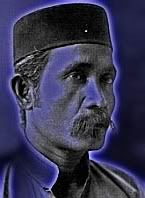Minyök Pök Ali
 This is the minyök that Pök Ali Yunang (Ali Zhang bin Idris) concocted in his shop, in a row of shophouses that is now demolished. The minyök was a popular remedy for aches, wind and the general under the weather conditions that visited folk in daily life. I obtained a bottle recently in Kuala Lumpur and am happy to report that the Pök Ali family are still making it for the market.
This is the minyök that Pök Ali Yunang (Ali Zhang bin Idris) concocted in his shop, in a row of shophouses that is now demolished. The minyök was a popular remedy for aches, wind and the general under the weather conditions that visited folk in daily life. I obtained a bottle recently in Kuala Lumpur and am happy to report that the Pök Ali family are still making it for the market.To read more about Pök Ali and how the Chinese Muslims arrived in Kuala Trengganu, read my earlier blog Snapshots of the Past and Hui Hui and Other People
The short stretch of road where Pök Ali kept his shop was known as Jalan Kampung Daik where now stands the Kuala Trengganu Fire Brigade and there is also a little musolla that we in our family referred to as "surau orang pasör", prayer house of the market people. Across the road from the Fire Brigade were Ah Chen, our family tailor [see Growing Up In Trengganu #197,325], and, just before the little bridge (known as the geretök) if you're coming from the White Mosque, was our shop of delights, the Keda BBunga (the flowered shop) where a Chinese man whom Mother called Awang sold oranges and lychees, Chinese pears and apples from colder climes. He also had glass jars of fruits, preserved in China, and they came in garish colours. And there was also something dried and squashed that had the feel of leather, and covered in white dust. We called it buöh ssemök which we took home and soaked in water for a few hours to bring it back to life. I later discovered that it was actually dried Japanese kaki fruit, or what we sometimes called pisang kaki in Malay.
I am grateful to alManar for giving us a wonderful account of life in this corner of town in the 1940s [see, Comments. to my blog Time for a Tower, below].
Geretök Note:
Whilst geretök is the accepted Trengganuspeak word for bridge, ttiang is the word used in everyday language. For instance, my mother used to refer to that spot where the Keda Bbunga stood as atah ttiang, meaning "on the bridge". Ttiang is no doubt from the standardspeak titian, a word that conjures a picture of someone balancing himself/herself on a dead tree trunk laid across a rivulet. Put a bundle of goods wrapped in a batik sarong on the head of a woman balancing herself on the ttiang, and you'll understand what mishap bored children prayed for on a dull day in the villlage. The bridge over the water in Jalan Kampung Daik was no mean bridge, but it was still tttiang for Trengganu folk. There was, I think, another ttiang in Banggol, known widely as Ttiang Banggol, and you can't fault them for that.
Labels: alManar, Jalan Kampung Daik, Minyok Pok Ali, Pok Ali Yunang



